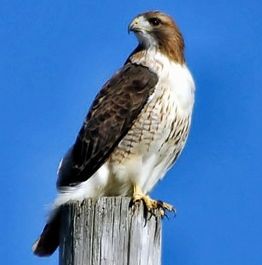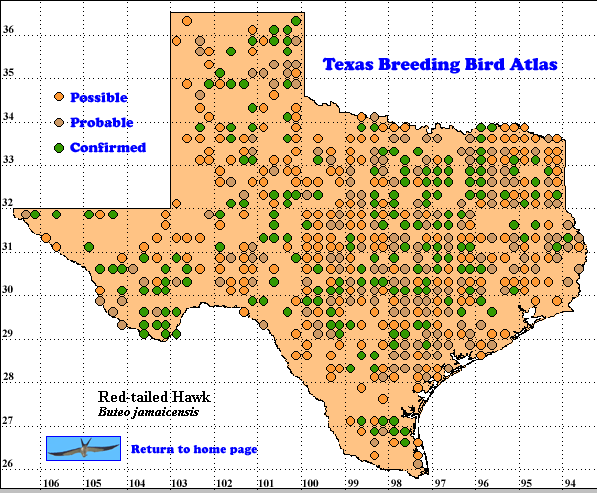Red-tailed Hawk is a widespread North American species and one of the most commonly-seen diurnal raptors on this continent. Because of its extensive plumage variability with dark and light phases, identification can sometimes be difficult. Even a sitting bird with a folded tail can be challenging. The often useful “belly-band” may be very faint or concealed in a dark-phase individual. As many as 16 subspecies are recognized and B. j. harlani, of Alaska and northwest Canada was previously considered a separate species because of its distinctive plumage (Preston and Beane 1993).
A “sit-and-wait” predator, this hawk feeds on a wide variety of mammals, birds, insects and even fresh carrion, items most easily found in its preferred “open woodland” type habitats (Preston and Beane 1993).
DISTRIBUTION. During the 1987-1992 field work seasons of the TBBA project, researchers found 196 confirmed breeding sites, 275 probable and only 20 possible sites for Red-tailed Hawk. Breeding Bird Survey (BBS) data produce a similar map to the one below. BBS relative abundances are similar across the state, except for the High Plains, Pineywoods and lower Rio Grande Valley where these hawks are less common (see the region map in Lockwood and Freeman [2004]; Sauer et al. 2007)..
The breeding range of Redd-tailed Hawks extends from central Alaska across Canada to the Maritime Provinces, then south through the United States, Baja California and the highlands of Mexico and Central America to western Panama. Breeding also occurs on many islands in the northern West Indies. In winter Alaskan and Canadian populations move south along with those on the northern Great Plains, to winter through the remaining breeding area and Mexican coastal lowlands (Stiles and Skutch 1989, Preston and Beane 1993, Howell and Webb 1995, Am. Ornithol. Union 1998, Sauer et al. 2007).
SEASONAL OCCURRENCE. Red-tailed Hawks are resident in Texas with the breeding population augmented during the migration and winter seasons by northern breeders. In winter, this species is common throughout Texas from mid-October to mid-March. Breeding in Texas occurs from late February to late June, based on egg dates from March 2 to May 25. (Oberholser 1974, Lockwood and Freeman 2004).
BREEDING HABITAT. Red-tailed Hawks breed in Texas from near sea level to about 1500 m (5000 ft) in a variety of habitats (Oberholser 1974). TBBA and BBS data (Sauer et al. 2007) suggest these hawks are more common in open wooded and shrub habitats and less common in denser forests and unbroken grasslands. In the Coastal Sand Plain of south Texas, these hawks nest in woodlands adjacent to savannas in trees with average heights of 10.1 m (34 ft) and canopy diameters of 13.7 m (45 ft). In the Texas Panhandle, nests were found in canyons (Patrikeev 2007). In Colorado where breeding was widely distributed across the state, common habitats included: pinyon-juniper, ponderosa pine, upland conifer, upland and lowland riparian, prairies and croplands (Preston 1998), while in Oklahoma atlasers mentioned woodlots, woodland edges, agricultural lands and plains (Jenkins 2004). In Arizona, Sonoran desert habitats made up nearly half of the total sites with pinyon-juniper about 11% and the rest scattered widely (Wise-Gervais 2005).
Nests are usually placed to be easily approached from above and to have a wide view, such as in the top of a tall tree or structure. Nests are built or refurbished by both sexes using deciduous sticks 1-2 cm ((0.4-0.8 in) in diameter. The nest cup is usually lined with bark strips, fresh coniferous or deciduous sprigs and other vegetation. In this cup the female usually lays 2-3 white to light buff eggs at 2-day intervals. Buff to red-brown or purple markings vary from sparing to heavy. Incubation starts after the first egg is laid and lasts 28-35 days with both parents participating. Young birds usually remain in the nest for 42-46 days and then spend another 7-8 weeks with their parents (Preston and Beane 1993).
STATUS. Red-tailed Hawks are common residents almost everywhere in Texas (Lockwood and Freeman 2004). BBS data for the period 1980-2006, derived from 155 routes, produce a statistically significant annual population change of +2.5% . This trend is slightly larger than the comparable trend for North America of +1.7% derived from 2996 routes (Sauer et al. 2007). The future in Texas for this adaptable species seems promising.
Text by Robert C. Tweit (2007)
Literature cited.
Actkinson, M. A., W. P. Kuvlesky Jr., C. W. Boal, L. A. Brennan and F. Hernandez. 2007. Nesting habitat relationships of sympatric Crested Caracaras, Red-tailed Hawks and White-tailed Hawks in south Texas. Wilson J. Ornithol. 119: 570-578.
American Ornithologists’ Union. 1998. Checklist of North American birds, 7th ed. Am, Ornithol. Union, Washington, DC.
Howell, S. N. G. and S. Webb. 1995. A guide to the birds of Mexico and northern Central America. Oxford University Press, New York.
Jenkins, M. A. 2004. Red-tailed Hawk (Buteo jamaicensis). In Oklahoma Breeding Bird Atlas, pp. 102-103 (D. L. Reinking, ed.). University of Oklahoma Press, Norman.
Lockwood, M. W. and B. Freeman. 2004. The TOS handbook of Texas birds. Texas A&M University Press, College Station.
Oberholser, H. C. 1974. The bird life of Texas, University of Texas Press, Austin.
Patrikeev, M. 2007. Breeding birds of Lake Meredith National Recreation Area and Alibates Flint Quarry National Monument. Bull. Texas Ornithol.Soc. 40: 1-14.
Preston, C. R. 1998. Red-tailed Hawk (Buteo jamaicensis). In Colorado Breeding Bird Atlas, pp. 120-121 (H. E. Kingery, ed.), Colorado Bird Atlas Partnership, Denver.
Preston, C. R. and R. D. Beane. 1993. Red-tailed Hawk (Buteo jamaicensis). In The Birds of North America, No. 52 (A. Poole and F. Gill, eds.). The Birds of North America, Inc., Philadelphia, PA.
Sauer, J. R., J. E. Hines, and J. Fallon. 2007. The North American Breeding Bird Survey, results and analysis 1966-2006. Version 7.23.2007. USGS Patuxent Wildlife Research Center, Laurel MD < http://www.mbr-pwrc.usgs.gov/bbs>
Wise-Gervais, C. 2005. Red-tailed Hawk (Buteo jamaicensis). In Arizona Breeding Bird Atlas. pp. 146-147 (T. E. Corman and C. Wise-Gervais, eds.), University of New Mexico Press, Albuquerque.

